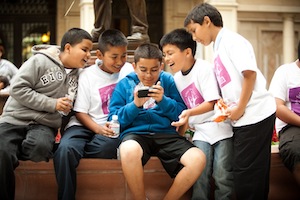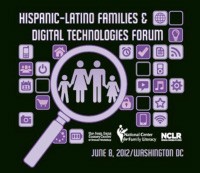 In my first post from the Hispanic-Latino Families and Digital Technologies Forum, I described participants’ commentary regarding the importance of digital literacy for advancing equity and the need to ensure high quality content and engagement in order to optimize the enormous educational potential of digital media. Numerous participants in the forum also stressed the constant need for respect, understanding, and learning from the intricacies of a culture as rich and as the growing US Hispanic-Latino population. In this post I provide a snapshot of participants’ efforts to understand the incredible demographic shift in the United States generated by rapid growth of the Hispanic-Latino population, and given this expansion, to grapple with best practices for communicating with and teaching learners of all cultures in a digital age.
In my first post from the Hispanic-Latino Families and Digital Technologies Forum, I described participants’ commentary regarding the importance of digital literacy for advancing equity and the need to ensure high quality content and engagement in order to optimize the enormous educational potential of digital media. Numerous participants in the forum also stressed the constant need for respect, understanding, and learning from the intricacies of a culture as rich and as the growing US Hispanic-Latino population. In this post I provide a snapshot of participants’ efforts to understand the incredible demographic shift in the United States generated by rapid growth of the Hispanic-Latino population, and given this expansion, to grapple with best practices for communicating with and teaching learners of all cultures in a digital age.
Abandoning the Deficit Model in Favor Greater Understanding of Hispanic-Latino Families
Mark Lopez from the Pew Hispanic Center presented findings regarding demographic shifts in the US and Hispanic-Latinos’ ownership and usage rates of cell phones, smart phones, and tablets. These stats reinforced the critical nature of research, practice, and policy work in this area; the US Hispanic-Latino population is growing, is younger as a whole than other populations, and is closing technology access gaps at remarkable rates. Several participants at the forum stressed the need now for more in-depth information about the nature of their participation with those technologies. For example, we need to know what purposes Hispanic-Latinos perceive for various technologies, what fears they might have regarding those technologies, and when and how they prefer information to be delivered. Jeanette Betancourt of Sesame Workshop acknowledged the positive role parents have to play and the need to better understand how and why they view and use certain technologies. Not everyone who owns the same device, she reasoned, perceives or uses it in the same way. Jeanette discussed a cornerstone of the “Sesame Model” – talking to families themselves (the true experts!) to find out what a population thinks and needs from media and outreach before content creation and distribution.
Emily Kirkpatrick of the National Center for Family Literacy called us to empower families by making sure they “know they are being heard.” One seemingly minute but important consideration, she said, is the fact that often Hispanic-Latino parents are worried about breaking these new digital technologies. In turn, we are best to not assume what Hispanic-Latino families’ relationships with new media are; rather, our job is to empower families to know their own needs and concerns and articulate them in ways that will have impact.
Vikki Katz (Rutgers University) reminded us that we should not view the Hispanic-Latino families that we study in terms of how they differ from White, non-minority families. This type of “haves and have-nots” framework is particularly problematic as we know very little about non-white, non-majority families, their media use, and the underlying reasons for those media use patterns. She stressed that Hispanic-Latino families are diverse, even when considering just the cultural, linguistic, and generational differences between them. We must abandon our tendency to over-generalize when researching or working with Hispanic-Latino families because within each family exists a particular context of living and operating that drives their media use and other practices. Further, in non-English-dominant families, kids are often the face of their families as they “broker” across languages, communities, and institutions for greater understanding of America. Katz urged us all to consider the context of family responsibility, trust in the inherent Hispanic-Latino capacity and desire to raise a strong family, and build off of their socio-cultural assets. Overlooking these often complex family and Hispanic-Latino subgroup structures and practices will undermine our understanding of these families and could lead to inappropriately designed educational and outreach programs.
Dr. Vikki Katz (Rutgers University) discusses important factors to consider when studying Hispanic-Latino families.
Guadalupe Valdes of Stanford University and Patti Constantakis of Great Schools continued the conversation on the benefits of abandoning the all-too-common deficit model of thinking. They noted that Spanish-dominant Hispanic-Latinos respond more often to information presented to them in their own dialect. Valdes raised concerns that many people seem to want to change the behavior of Hispanic-Latino parents such that they are merely imitation White/non-Hispanic parents, disregarding deep-rooted differences in cultural and parenting norms between the groups. Valdes pointed out a cultural parenting difference whereby White, non-minority parents often view themselves as responsible for teaching their children academic knowledge, while Hispanic-Latino parents view themselves primarily as “good people makers,” and focus more on children’s behavior. What is consistent is that both communities of parents care very deeply about their children. She argued that tinkering with the strong and culturally informed Hispanic-Latino family ecosystem by forcing parents into roles as “adjunct teachers” could have unfavorable repercussions. Therefore, we must learn to communicate with Hispanic-Latino parents in a way that respects their great knowledge and capacity as parents and family members, and also helps them to harness the learning potential of digital technologies.
In the next and final post, I will call for increased acute attention directed to research process design. We must keep in mind first and foremost that a primary goal in transforming and growing research around this area of study is to paint a more accurate and detailed picture of the lives, family structures, and needs of Hispanic-Latinos and their interactions with new media.



